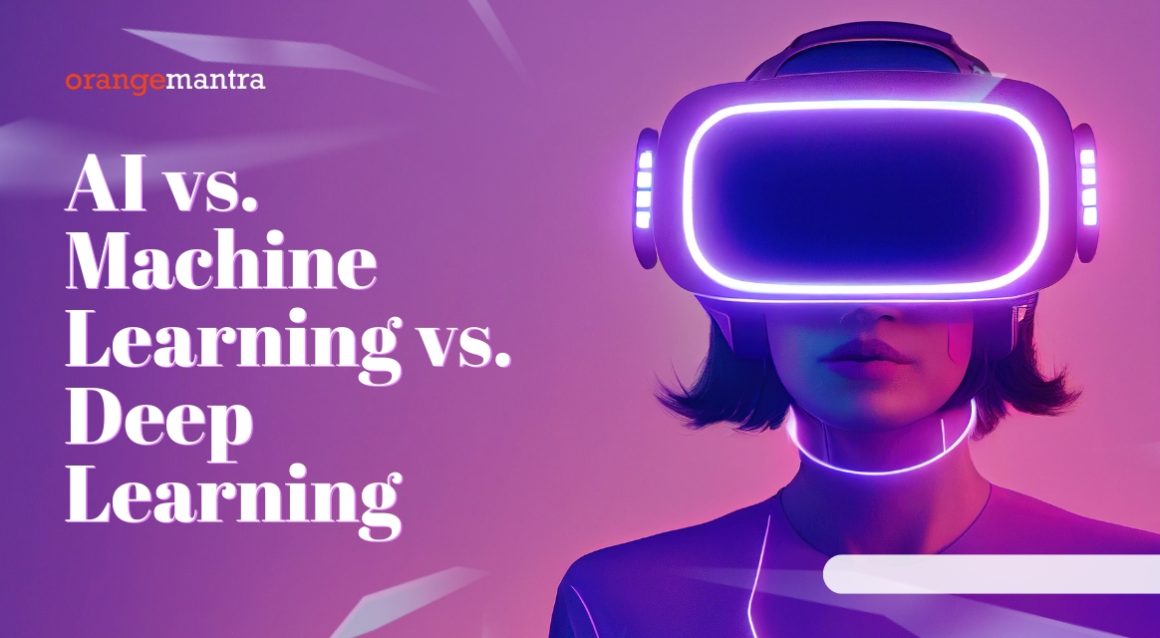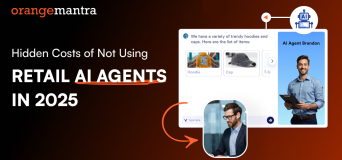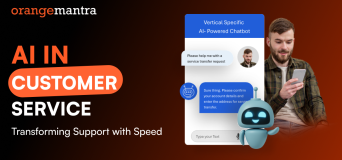In today’s fast-paced digital world, innovation and technology directly influence how businesses operate and connect with their audience. Artificial intelligence AI vs Machine learning vs Deep learning has been a game-changer, revolutionizing sectors by enabling robots to perform tasks once reserved for human intellect. AI vs Machine learning vs Deep learning play key roles in this transformation. This or any other term will be defined, and aspects of distinction will be discovered. Such as what one distinguishes AI, and other machine learning terms.
So, in this blog, let’s Understand about the AI vs Machine learning vs Deep learning.
Application of AI vs Machine Learning
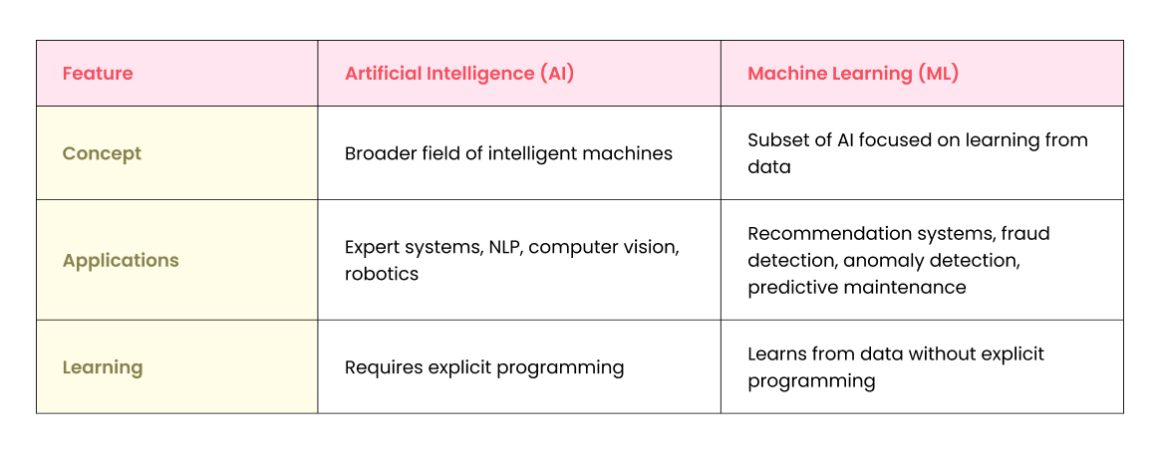
AI Development Outlook in 2024 and Main Trends
Machine learning is on the verge of major developments that will project AI forward. AI is where is right now being measured by the most recent statistics, data, and trends. Taking investment and use go higher and higher. AI apps are like water that penetrates all layers of life from dialog programs that talk to us to cars operating on their own and being able to create different industries and jobs for us.
Can we talk about deep learning, AI, machine learning, and neural networks as one concept, divided into separate parts?
We also need to stamp in our mind the relationship between:
- Artificial intelligence,
- Machine learning,
- Deep learning,
- Neural network concepts
of which the exact nature may be understandable afterward. Machine learning, a sub-area of artificial intelligence, allows computers to learn from the data given. However, is the more general one, where intelligent tasks can be carried out through machines. AI and deep learning are distinct categories as deep learning is part of machine learning which is a neuro-inspired structure of artificial neural networks.
What is the definition of AI?
The term “artificial intelligence” describes how computers may mimic human intellectual functions such as learning, thinking, and problem-solving. It is divided into two categories: general AI, which can do any intellectual work that a person can, and narrow AI, which is made for a particular purpose.
However, AI in business may boost productivity, stimulate innovation, and facilitate better decision-making. These technologies provide organizations with a competitive advantage in today’s data-driven economy, from personalized marketing techniques to predictive analytics.
Machine learning: What is it?
The goal of machine learning, a branch of artificial intelligence, is to empower computers to learn from data without explicit programming. Machine learning algorithms are capable of pattern recognition, prediction, and continuous performance improvement via the use of statistical models and algorithms.
Distinctions between AI vs Machine learning vs Deep learning
Neural networks, with their multiple layers capable of learning hierarchical representations, are utilized in deep learning, a specialized form of machine learning. Deep learning models excel at challenging tasks such as image recognition and natural language processing, as they can automatically extract features from raw data, unlike traditional machine learning methods.
Explain neural networks.
A neural network is a kind of computer model that draws inspiration from the composition and operations of the human brain. It is made up of networked nodes, or neurons, arranged in layers to process inputs and produce outputs. AI vs machine learning extracts complex patterns from data by using multi-layered neural networks.
What distinguishes neural networks from deep learning?
Deep learning is the process of learning data representations via the use of multi-layered neural networks, even though it is based on neural networks as well. On the other hand, AI vs neural learning a wider variety of computational models influenced by the neuronal structure of the brain are included in neural networks.
Taking care of your AI data
AI depends on data, and efficiently managing it is essential to ensuring that AI systems reach their full potential. AI vs machine learning guarantee the quality and applicability of their data, organizations need to put strong data management systems into place, from data collection and storage to processing and analysis.
5G’s future: What to anticipate from this revolutionary technology
The upcoming 5G release will become a new guidance in our lives how we interact with each other. The 5G paradigm will spark an evolutionary path into a brand-new space where unprecedented speeds, significantly lower latency values, and an overall larger capacity will be an inevitable consequence of the new technology.
How utility scales up the recovery by employing data and AI in regards with extreme weather conditions.
The utilities should be basing on data to ensure that their resilience is strengthened and that they are prepared for the future of climate change that is characterized by natural catastrophes. AI vs deep learning utility use will be able to lower the influence of catastrophes by analyzing the history, data of the past, predicting future patterns and it will assure the continuation of the critical services by taking precautions actions.
As eCommerce continues to evolve and expand, it remains to be seen whether these six trends will prioritize customer trust and experience or overshadow them.
Some key technological advances and the customer behavior which is always changing all the time have made eCommerce industry to change the way it operates. The one way of remaining competitive in the digital marketplace is companies’ ability to keep up with the current trends and explore potential in technologies. This can be applied to such things as augmented reality purchasing and personalize shopping experiences.
The fluctuation in the buyer behaviors and technical creativity of the eCommerce market will keep it developing constantly. Companies have no time to delay in new trends discovery and use of new tech, being able to be flexible to maintain the competitive advantage in the digital economy.
Here are six major eCommerce trends to keep an eye on:
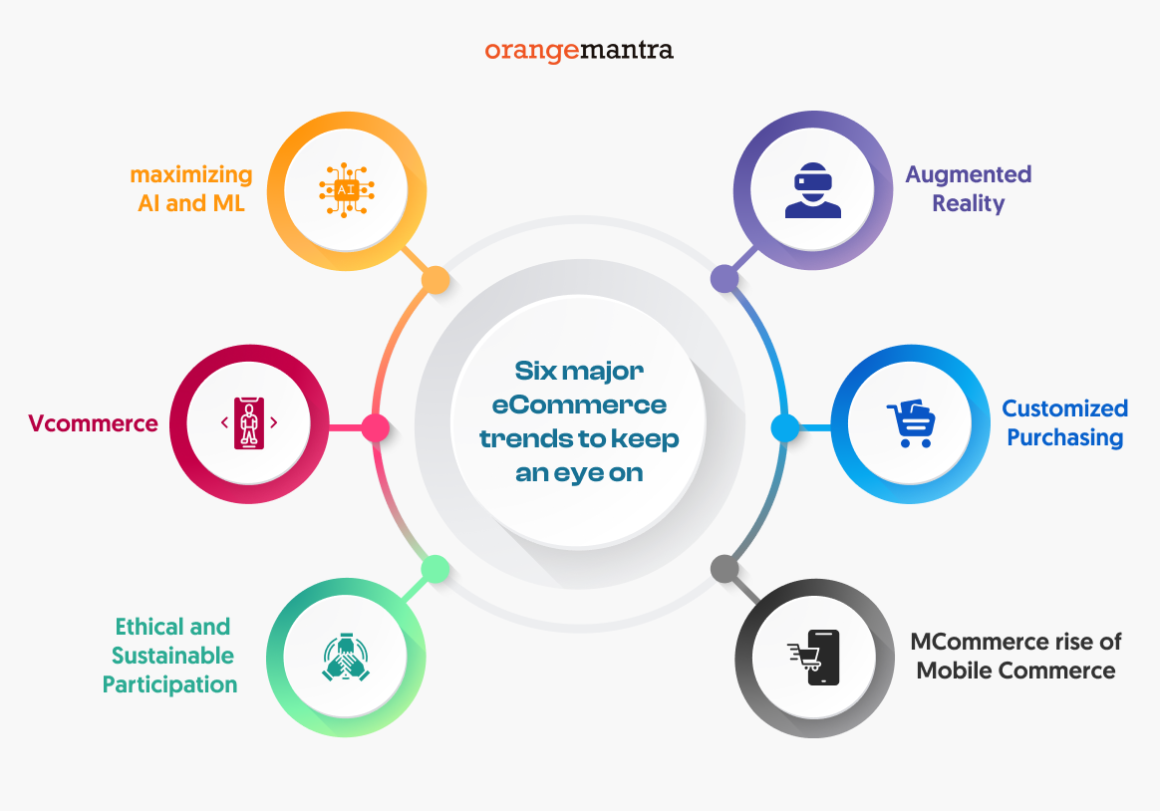
1. Buying the headsets of Augmented Reality is the gateway exchange service (AR).
Nowadays, online shopping is undergoing the treatment by the AR technologies revolution. AR allows consumers to see an item in its own surroundings and in front of their eyes, as it can blur the digital pictures with reality by projecting virtual things over the real environment. This lets the customer enjoy a convenient shopping experience for retail organizations that aim at boosting conversions and customer happiness. The process elevates customers’ confidence level and minimizes chances of return. This is because they get to see their looks in the actual outfit.
2. Customized Purchasing Journeys
Nowadays, a key component of effective eCommerce tactics is personalization. Businesses may customize website content, marketing messaging, and product suggestions to the unique interests and behaviors of each consumer by using data analytics and artificial intelligence. AI vs machine learning customized strategy encourages repeat business and client loyalty in addition to improving the purchasing experience.
3. MCommerce rise of Mobile Commerce
M-commerce, mobile commerce, is what is considered to be a booming area in the eCommerce sphere, due to a dramatic increase in the use of smartphones and tablets. People rarely purchase items with their computers anymore; instead, they prefer using websites and applications that are mobile-compatible, since they want to have a smooth shopping experience with whatever device they use. AI vs deep learning also help in the development of electronic wallets and the advancement of mobile payment options have enabled consumers the benefit from quicker checkouts, which ultimately influences the increasing popularity of mCommerce.
4. Integration of voice commerce (Vcommerce)
The consumer interface has been altered with the advent of voice technology in the form of virtual assistants and smart speakers thus paving the way for a brand-new connected experience for its users. VCommerce allows its users to search for goods, places, and track delivery services by using their voice commands. This allows customers to conveniently shop around without using hands. Companies would attract more customers as a competitive edge and gain market share by incorporating voice commerce features into their platforms.
5. Ethical and Sustainable Participation
More and more consumers are looking for sustainable and ethically sourced products and they are willing to pay a bit more when societal and ecological concerns are taken into consideration. Thus, e-commerce companies in turn have put in place eco-friendly procedures and reduced the packaging and shipping waste by cutting this out. Also, the ethical supply networks are strengthened. AI vs machine learning create a potential consumer group & prospective customer with an ecologically conscious mindset, ethical brands with higher attention to sustainable business practices and social well-being also make a good change to society overall.
6. By maximizing AI and ML for Images
Slowly but surely the eCommerce procedures are coming across improved as the AI/ML technology is being used to optimize them. The use of Artificial intelligence and Machine learning development algorithms by businesses in predicting operations, improving workflows, and making decisions in other areas like fraud detection, inventory management, and demand forecasting is more popular than ever. Furthermore, companies that specialize in the development of machine learning for eCommerce businesses could greatly enhance their performance, cut costs, and elevate the whole service levels by incorporating AI and ML.
More in the field of artificial intelligence
Artificial Intelligence has boundless potential and may be used in a wide range of businesses and areas. AI technologies are revolutionizing industries, spurring innovation, and improving user experiences in everything from healthcare to banking.
Six ways AI improves the hiring process
AI technologies provide a solution by simplifying and automating different components of the recruiting process, which might otherwise be time- and resource-intensive. So, AI solutions may shorten recruiting deadlines, enhance applicant quality, and lessen prejudice in the hiring process, from resume screening to candidate matching.
Of course! Six ways that AI enhances the employment process are as follows:
1. Effective Sourcing of Candidates
Artificial intelligence (AI)-driven algorithms can discover the best applicants based on preset criteria like skills, experience, and credentials by sorting through massive quantities of resumes and applications much more quickly than people can.
2. Improved Candidate Authentication
AI can evaluate applicant profiles by comparing the candidate’s qualities, experience, and abilities to the job criteria. Chatgpt integration guarantees a more impartial review procedure and cuts down on the amount of time needed for manual screening.
3. Personalized Candidate Engagement
AI technologies allow for large-scale, personalized engagement with applicants. They let them know when their applications are being reviewed, set up interviews and send them pertinent information to keep them interested in the job.
4. Reduction of Bias
Artificial Intelligence (AI) helps reduce unconscious bias in the recruiting process by concentrating only on credentials and performance indicators. NLP services ensure that every applicant is treated fairly and promotes diversity and inclusion.
5. The Use of Predictive Analytics
Recruiters may make data-driven choices regarding applicant selection, retention, and workforce planning by using AI algorithms to analyze past recruiting data and spot patterns and trends.
6. Streamlined Onboarding
Artificial intelligence (AI)-enabled chatbots and virtual assistants can assist recent hires with the onboarding process by responding to inquiries, offering training materials, and assisting with integration into the company culture. This enhances the candidate experience overall and cuts down on productivity time.
AI will transform the world; we must decide how
It’s critical to steer the discourse about the ethical, legal, and social ramifications of artificial intelligence. This is especially important as we traverse its rapidly evolving environment. AI development company can harness artificial intelligence’s transformational capacity for the benefit of society as a whole by establishing the rules and regulations regulating its development and use.
Final Thoughts
Finally, Deep learning, artificial intelligence, machine learning, and neural networks are vital components of today’s fast-paced tech landscape. Understanding their differences and connections empowers businesses to innovate, make better decisions, and explore new opportunities. As AI’s potential expands, setting clear guidelines will shape its impact on society.
FAQ
1. What is the key aspects of AI and ML?
Understanding the difference between machine learning and artificial intelligence lies in their core principles. Machine learning relies on data accuracy, unlike human intellect, which solves problems through judgment. Machine learning is data-driven, teaching computers to predict or make decisions without explicit instructions
2. what is the meaning that machine learning is the mechanism that an AI is based on?
AI, or Artificial Intelligence, includes methods for computer study and work. These methods encompass pattern recognition, decision-making, regression, and text comprehension. Algorithms, a subset of AI, constantly improve through machine learning, utilizing data as their primary resource.
3. Which the application is using artificial intelligence vs machine learning in one go?
Machine learning algorithms play a crucial role in detecting financial sector frauds. Enhancing visual recognition in security systems, and powering recommendation systems like those used by Amazon and Netflix
4. Do AI systems use machine learning all the time?
It’s crucial to address a common question: how much do AI technologies rely on machine learning? Machine learning isn’t the sole tool in AI systems. Rule-based systems follow fixed rules, while machine learning mimics human learning by recognizing patterns in data. Its ability to evolve annually has made it popular in AI. Its increased use in recent years signifies its importance.
5. If we consider the computational complexity of machine learning or artificial intelligence, which one is more complex?
In contrast, machine learning and artificial intelligence both appear to be diving equally into the pit. This could require both multidisciplinary and interdisciplinary practices involve experts from fields like anthropology, natural science, and psychology.
